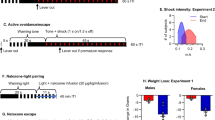Abstract
Rats given d-amphetamine and placed in a tank of water repeatedly dive towards the bottom of the tank. Two experiments investigated this stereotypy. The first established a dose-response function for the stereotypy and the second showed that experience with the apparatus prior to drug administration disrupted the stereotypy. The latter result is consistent with the findings of previous work and thus provides a degree of generality for the role of experience interacting with CNS drugs to induce stereotypies.
Similar content being viewed by others
References
Andrews KD, Fernando JCR, Curzon G (1982) Differential involvement of dopamine-containing tracts in 5-hydroxytryptamine-dependent behaviors caused by amphetamine in large doses. Neuropharmacology 21:63–68.
Cole O (1977) Interaction of arena size with different measures of amphetamine effects. Pharmacol Biochem Behav 7:181–184.
Cole SO (1967) Experimental effects of amphetamine: a review. Psychol Bull 68:81–90.
Curzon G, Fernando JCR, Lees AT (1979) Backward walking and circling: behavioral responses induced by drug treatments which cause simultaneous release of catecholamines and 5-hydroxytryptamine. Br J Pharmacol 66:573–579.
DeVietti TL, Pellis SM, Pellis VC, Teitelbaum P (1985) Previous experience disrupts atropine-induced stereotyped “trapping” in rats. Behav Neurosci 99:1128–1141.
Dickinson SL, Curzon G (1983) Roles of dopamine and 5-hydroxytryptamine in stereotyped and non-stereotyped behaviors. Neuropharmacology 22:805–812.
Dickinson SL, Andrews CD, Curzon G (1984) The effects of lesions produced by 5-7-hydroxytryptamine on 5-hydroxytryptamine mediated behavior induced by amphetamine in large doses in the rat. Neuropharmacology 23:423–430.
Fog R (1972) On stereotypy and catalepsy: studies on the effect of amphetamine and neuroleptics in rats. Acta Neurol Scand 48:1–66.
Furchtgott E (1971) Pharmacological and biophysical agents and behavior. Academic Press, New York
Holmgren B, Urba-Holmgren R, Valdes M (1976) Relative role of catecholamines in head-shaking of infant rats. Pharmacol Biochem Behav 5:29–34.
Jersussi TP, Glick SD (1976) Drug-induced rotation in rats without lesions: behavioral and neurochemical indices of a normal asymmetry in nigro-striatal function. Psychopharmacology 47:249–260.
Kirk RE (1982) Experimental design: procedures for the behavioral sciences. Brooks/Cole, Monterey
Lees AJ, Fernando JCR, Curzon G (1979) Serotonergic involvement in behavioral responses to amphetamine at high doses. Neuropharmacology 21:63–68.
Lyon M, Robbins TW (1975) The action of central nervous system stimulant drugs: a general theory concerning amphetamine effects. In: Essman W, Valzelli L (eds) Current developments in psychopharmacology. Spectrum, New York, pp 79–263.
Pijnenburg A, Honig W, Van Rossum J (1975) Antagonism of apomorphine- and d-amphetamine-induced stereotyped behavior by injection of low doses of haloperidol into the caudate nucleus and the nucleus accumbens. Psychopharmacologia 45:65–71.
Quock R, Horita A (1976) Differentiation of neuropharmacological actions of apomorphine and d-amphetamine. Pharmacol Biochem Behav 5:627–631.
Randrup A, Munkvad I (1967) Stereotyped activities produced by amphetamine in several animal species and man. Psychopharmacologia 11:300–310.
Rylander G (1971) Stereotyped behavior in man following amphetamine abuse. In: Baker SB de C (ed) The correlation of adverse effects in man with observations in animals. Exerrpta Medica, Amsterdam, pp 28–31.
Sahakian B, Robbins TW (1975) The effects of test environment and rearing condition on amphetamine-induced stereotypy in the guinea pig. Psychopharmacologia 45:115–117.
Sahakian B, Robbins TW, Morgan M, Iversen D (1975) The effects of psychomotor stimulants on stereotypy and locomotor activity in socially-deprived and control rats. Brain Res 84:195–205.
Schallert T, DeRyck M, Teitelbaum P (1980) Atropine stereotypy as a behavioral trap: a movement subsystem and EEG analysis. J Comp Physiol Psychol 94:1–24.
Segal DS, Schuckit MA (1983) Animal models of stimulant-induced psychosis. In: Creese I (ed) Stimulants: neurochemical, behavioral, and clinical perspectives. Raven Press, New York, pp 131–167.
Sirkin D, Teitelbaum P (1983) The pontine reticular formation is part of the output pathway for amphetamine- and apomorphine-induced lateral head movements: evidence from experimental lesions in the rat. Brain Res 260:291–296.
Szechtman H, Ornstein K, Teitelbaum P, Golani I (1985) The morphogenesis of stereotyped behavior induced by the dopamine receptor agonist apomorphine in the laboratory rat. Neuroscience 14:783–798.
Teitelbaum P (1986) The lateral hypothalamic double disconnection syndrome: a reappraisal and a new theory for recovery of function. In: Hulse SH, Green Jr BF (eds) G. Stanley Hall: essays in honor of 100 years of psychological research in America. The John Hopkins Universität Press, Baltimore, pp 79–125.
Teitelbaum P, Pellis S, DeVietti T (1988) Disintegration into stereotypy induced by drugs or brain damage: a micro-descriptive behavioral analysis. In: Cooper SJ, Dourish CJ (eds) Behavioural stereotypy. Oxford University Press, Oxford
Author information
Authors and Affiliations
Rights and permissions
About this article
Cite this article
Petree, A.D., DeVietti, T.L. Previous experience disrupts d-amphetamine-induced stereotypic diving in rats. Psychopharmacology 97, 462–465 (1989). https://doi.org/10.1007/BF00439548
Received:
Accepted:
Issue Date:
DOI: https://doi.org/10.1007/BF00439548




